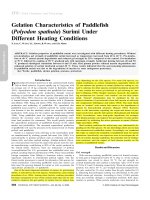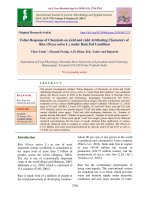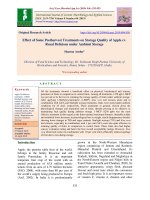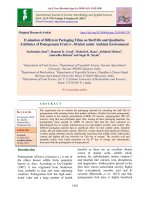Ripening behaviour of chitosan coated sapota fruits under low temperature storage condition
Bạn đang xem bản rút gọn của tài liệu. Xem và tải ngay bản đầy đủ của tài liệu tại đây (226.02 KB, 7 trang )
Int.J.Curr.Microbiol.App.Sci (2018) 7(10): 2784-2790
International Journal of Current Microbiology and Applied Sciences
ISSN: 2319-7706 Volume 7 Number 10 (2018)
Journal homepage:
Original Research Article
/>
Ripening Behaviour of Chitosan Coated Sapota Fruits under Low
Temperature Storage Condition
Prahlad Deb1* and S. Gautam2
1
Department of Horticulture & Postharvest Technology, Institute of Agriculture,
Visva-Bharati, Sriniketan-731236, West Bengal, India
2
Food Science & Safety Section, Food Technology Division, Bhabha Atomic Research Centre,
Trombay, Mumbai, India
*Corresponding author
ABSTRACT
Keywords
Sapota, Chitosan
coating, Storage,
Quality
Article Info
Accepted:
20 September 2018
Available Online:
10 October 2018
Sapota (Achras zapota L.) is one of the tropical climacteric fruits preferred by the
consumers due to its sweet taste and aroma. Fruits become ripe very quickly after
harvesting due to sudden climacteric rise with high respiration rate and ethylene
production. This quick ripening causes loosening the texture of fruit leads to softening of
and spoilage. The short shelf life of the fruit is a marketing problem which is a major cause
of huge postharvest loss of this fruit. Edible coating of fruits can reduce the ripening rate
by making a thin layer above fruit surface to interfere gaseous exchange between air and
fruit which ultimately reduce respiration rate and ripening. Chitosan is one such edible
coating material frequently used in fruits to enhance storage life. In the present experiment
solution of chitosan powder (0.5, 1.0, 1.5 and 2.0% w/v) has been prepared in 0.5% glacial
acetic acid with surfactant and plasticizer. Freshly harvested and washed sapota fruits were
then dipped in coating solution for 1 min followed by air drying. Fruits were then stored in
controlled condition (12+1 oC, 85-90% RH). 1.5% chitosan coating resulted best for
keeping the maximum fruits (more than 75%) for 30 days under controlled condition.
Chitosan coating also reduced the physiological losses in weight compared to the uncoated
fruits. The same treatment has also resulted maximum retention of quality by maximum
TSS, total sugar and reducing sugar.
Introduction
Sapota (Achras zapota L.) is one of the
tropical climacteric fruits preferred by the
consumers due to its sweet taste and aroma.
Fruits are mainly used as table purpose as
fresh, fruit salad, milk shake or processed like
squash, jam, candy etc. The fruit is very
nutritious and rich in carbohydrate, calcium,
phosphorus and antioxidants like beta carotene
and ascorbic acid etc. In India major sapota
growing states are Karnataka, Maharashtra,
Gujarat, Tamil Nadu, Andhra Pradesh and
West Bengal (Anon. 2017). Fruits become ripe
very quickly after harvesting due to sudden
climacteric rise with high respiration rate and
ethylene production. The quick ripening of
fruits cause loosening the texture of fruit leads
to softening of and spoilage which is main
cause of perishable nature of the fruit (Jagtap
2784
Int.J.Curr.Microbiol.App.Sci (2018) 7(10): 2784-2790
and Katrodia, 1998). Sapota is one of the
climacteric fruit and thus the rise in respiration
rate and ethylene production is very quick and
high after harvest (Sankaranarayan et al.,
2007). High respiration results the loss of
stored carbohydrate causing deterioration of
fruit quality. Besides higher transpiration rate
causes maximum physiological losses in
weight and the fruits loss its turgidity. The
short shelf life of the fruit is a marketing
problem which is a major cause of huge
postharvest loss of this fruit. Inspite of the
considerable production of this fruit
tremendous post-harvest loss (Gajanana et al.,
2006) is one bottleneck to the growers.
Chitosan is a linear polysacchiride of (1, 4)
linked 2-amio-deoxy-β-D-glucan. It is a
deacetylated derivative of chitin which is a
naturally available polysaccharide (Youwei
and Yinzhe, 2013). It has found to be nontoxic,
biodegradable,
biocompatible
polysaccharide having antimicrobial and
antifungal activity (Majeti and Ravi, 2000).
This edible coating can form a semi permeable
film above fruit surface and can reduce
respiration rate by adjusting the permeability
of oxygen and carbon di-oxide. It can also act
as barrier to propagate harmful microbes
above fruit surface thus coated fruits can be
stored for longer period. Additionally chitosan
coating can also reduce the transpiration loss.
Considering these attributes chitosan is used
as edible coating in many fruits (Mohammed,
2010). Thus the present experiment was
undertaken to study the effect of chitosan
coating on sapota fruits on its ripening
behaviour under low temperature storage.
Materials and Methods
Present research work has been carried out at
the laboratory of Department of Horticulture
& Postharvest Technology, Institute of
Agriculture,
Visva-Bharati
University,
Sriniketan, West Bengal during the year 2015-
16. Following are the steps followed for the
present experiment.
Preparation of chitosan
treatment of fruits
solution
and
Chitosan powder of different concentrations
i.e. 0.5, 1.0, 1.5 and 2.0% w/v were dissolved
in 100 ml of 0.5% glacial acetic acid solution.
0.1ml each of tween-80 (as surfactant) and
glycerol (as plasticizer) were added to the
solution. The freshly harvested fruits were
washed in water dried and dipped in coating
solution for 1 min followed by air drying.
Fruits were then stored in controlled condition
(12+1 oC, 85-90% RH).
Observations recorded
Different observations have been taken on
each fifth day upto 35th day. The following are
the observations have considered in the
present experiment in the present study:
Physiological losses in weight (PLW)
The physiological losses in weight of fruit
mainly occur due to transpiration and
respiration. It was calculated with the
following formula:
Initial weight of fruits – Final weight of fruits
PLW (%) = --------------------------------- X 100
Initial weight of fruits
Fruit pressure
Fruit pressure actually denotes the turgidity of
the fruits and measured by fruit pressure
tester, expressed in Kg.
Shelf life
Number of healthy fruits out of 100 fruits was
considered as the indicator shelf life for
particular day. Maximum number in latest day
2785
Int.J.Curr.Microbiol.App.Sci (2018) 7(10): 2784-2790
of storage was considered maximum in
storage life.
Total Soluble Solid (TSS)
Total soluble solid of ber were estimated with
the help of a hand refractometer. A drop of
fruit juice was squeezed out and strained clear
juice was instilled on the plate to record the
refractometer reading, calibrated in o Brix at
room temperature.
Total sugar
Total sugar content of the fruit was
determined by titrimetic procedures. Firstly
non reducing sugar contain of pulp sample
was converted into reducing sugar by acid
hydrolysis. After conversion, the sugar of the
aqueous solution was determined by titrating
against the freshly made mixture containing
equal volume of Fehling’s solution.
Reducing sugar
The reducing sugar content of the aqueous
extract was determined by titrating against the
Fehling’s solutions as stated above.
Statistical analysis was done as per Gomez
and Gomez (1984) following the standard
procedure in Completely Randomized Design
with seven treatments and three replication.
Results and Discussion
Observations on physiological losses in
weight, fruit pressure, total soluble solids,
total sugar and reducing sugar have been taken
five days interval upto 35th day of storage and
the significant findings are as follows:
Physiological losses in weight (PLW)
In the present experiment chitosan coating
significantly reduced the physiological losses
in weight (Table 1). Maximum PLW was
recorded in control or non-coated fruits and it
was 17.23% on 35th day. Minimum PLW was
observed under chitosan @ 2.0% measured as
8.93% and 11.25% on 30th day and 35th day
respectively. Chitosan @ 1.5% resulted
10.34% of PLW on 30th days of storage and
13.07% on 35th day. This may be due to the
formation of a thin layer above the fruit
surface which prevented transpiration loss to a
certain limit (Macwan et al., 2018). This may
also be due to the formation of modified
atmosphere above the fruit surface which
inhibited the moisture loss and thereby
physiological losses in weight (Park, 1999).
Fruit pressure
In the present experiment chitosan coating of
fruits also resulted better fruit pressure
retention significantly (Table 2). Fruit pressure
retention was maximum upto 30th day (1.98
kg) in the fruits treated with chitosan @ 1.5%.
Fruit pressure has been then reduced to 1.46
kg on 35th day under chitosan @ 1.5%. 2.0%
chitosan coating of fruits also resulted higher
fruit pressure retention (1.72 kg) on 30th days
of storage. Textural loss of fruits were
observed in the fruits under no coating of
chitosan and it was observed significantly
minimum (1.50 kg on 30th day and 0.91 kg on
35th days of storage). The retention of fruit
pressure in the coated fruits is due to slower
ripening rate facilitated by the formation of
modified atmosphere by chitosan coating
(Vishwasrao and Ananthanarayan, 2016).
Shelf life
Chitosan coating enhanced the shelf life of
sapota fruits significantly in the present
experiment (Table 3). All the treated and nontreated fruits exhibited a good shelf life (more
than 80 percent fresh fruits) upto 30th days of
storage under controlled condition. However,
the fruits coated with chitosan @ 1.5%
2786
Int.J.Curr.Microbiol.App.Sci (2018) 7(10): 2784-2790
exhibited significantly maximum shelf life (86
fresh fruits) on 30th days of storage. A sudden
decrease in shelf life from 81 to 68 percent of
fresh fruits from 30th day to 35th day under
non-treated fruits was also noticed in the
present experiment. Dey et al., (2014)
reported better shelf life of fruits when edible
coating is applied. Menezes and Athmaselvi
(2016) also reported that the edible coating
can increase the shelf life of fruits. Thus the
findings of the present experiment is
scientifically justified by the findings of Dey
et al., (2014) and Menezes and Athmaselvi
(2016).
experiment (Table 4). The maximum rise of
TSS (23.1 oBrix) was observed in the fruits
treated with chitosan @ 1.5% on 30th days of
storage.
Total Soluble Solid (TSS)
Perhaps higher TSS in chitosan coated fruits
was due to the slower respiration rate
enhanced by modified atmosphere formed
with chitosan layer (Park, 1999).
In every treatment a rise in the content of total
soluble solids was observed in the present
On contrary non-coated and other chitosan
coated fruits @ 0.5, 1.0 and 2.0% showed
maximum rise of TSS on 25th days of storage
measuring 21.9, 22.5, 21.8 and 21.3 oBrix
respectively. It indicates the slow ripening in
case of chitosan coating @ 1.5% and faster
ripening in other cases. Similar finding was
observed by Tharanathan (2003), Dey et al.,
(2014) and Menezes and Athmaselvi (2016).
Table.1 Changes in Physiological losses in weight (PLW %)
Treatments
1st
day
5th
day
10th
day
15th
day
20th
day
25th
day
30th
day
35th
day
T1 (Chitosan @ 0.0%)
T2 (Chitosan @ 0.5%)
T3 (Chitosan @ 1.0%)
T4 (Chitosan @ 1.5%)
T5 (Chitosan @ 2.0%)
SE+M
CD (0.05)
0.0
0.0
0.0
0.0
0.0
--
1.25
1.20
1.01
0.95
0.78
NS
3.93
2.08
1.97
1.53
1.15
0.12
6.55
4.26
4.67
3.96
3.48
0.10
--
NS
0.36
0.31
8.17 10.42 14.78 17.23
6.46 9.55 12.31 15.94
5.93 8.80 11.15 13.53
5.64 8.88 10.34 13.07
5.31 6.88 8.93 11.25
0.13 0.17 0.19 0.28
0.40 0.52 0.57 0.84
Table.2 Changes in fruit pressure (Kg)
Treatments
T1 (Chitosan @ 0.0%)
T2 (Chitosan @ 0.5%)
T3 (Chitosan @ 1.0%)
T4 (Chitosan @ 1.5%)
T5 (Chitosan @ 2.0%)
SE+M
CD (0.05)
1st
day
3.56
3.49
3.50
3.51
3.46
NS
NS
5th
day
3.24
3.11
3.20
3.36
3.07
NS
NS
10th
day
3.03
2.95
3.05
3.11
2.97
NS
NS
2787
15th
day
2.86
2.72
2.79
2.93
2.69
NS
NS
20th
day
2.51
2.45
2.46
2.67
2.32
NS
NS
25th
day
2.20
2.08
2.10
2.36
2.05
NS
NS
30th
day
1.50
1.57
1.63
1.98
1.72
0.07
0.23
35th
day
0.91
0.99
0.93
1.46
1.10
0.06
0.20
Int.J.Curr.Microbiol.App.Sci (2018) 7(10): 2784-2790
Table.3 Shelf life of fruits (no. of healthy fruits)
Treatments
T1 (Chitosan @ 0.0%)
T2 (Chitosan @ 0.5%)
T3 (Chitosan @ 1.0%)
T4 (Chitosan @ 1.5%)
T5 (Chitosan @ 2.0%)
SE+M
CD (0.05)
1st
day
100
100
100
100
100
NS
NS
5th
day
100
100
100
100
100
NS
NS
10th
day
100
100
100
100
100
NS
NS
15th
day
100
100
100
100
95
NS
NS
20th
day
94
96
95
99
91
0.68
2.05
25th
day
87
91
89
93
84
1.24
3.72
30th
day
81
80
80
86
79
1.37
4.11
35th
day
68
72
74
78
70
1.26
3.78
25th
day
21.9
22.5
21.8
22.7
21.3
0.35
1.06
30th
day
20.3
21.1
20.4
23.1
19.5
0.48
1.41
35th
day
18.6
19.3
18.7
21.6
18.0
0.44
1.32
25th
day
15.6
14.8
16.1
14.5
15.2
0.40
1.22
30th
day
15.2
16.0
15.7
18.2
14.3
0.46
1.05
35th
day
13.5
15.1
15.2
17.4
13.0
0.39
1.16
25th
day
7.6
7.9
8.1
8.4
7.2
0.30
0.90
30th
day
7.0
8.7
7.5
9.7
6.5
0.29
0.85
35th
day
6.2
6.8
7.0
8.5
6.1
0.30
0.88
Table.4 Changes in total soluble solids (TSS oBrix)
Treatments
T1 (Chitosan @ 0.0%)
T2 (Chitosan @ 0.5%)
T3 (Chitosan @ 1.0%)
T4 (Chitosan @ 1.5%)
T5 (Chitosan @ 2.0%)
SE+M
CD (0.05)
1st
day
7.2
7.5
7.6
7.1
7.4
NS
NS
5th
day
11.8
11.0
11.4
10.5
10.8
NS
NS
10th
day
15.7
14.5
14.2
13.7
13.6
0.40
1.11
15th
day
17.5
18.1
17.2
16.5
16.9
0.42
1.20
20th
day
19.4
20.7
18.9
19.2
19.7
0.35
1.02
Table.5 Changes in total sugar (%)
Treatments
T1 (Chitosan @ 0.0%)
T2 (Chitosan @ 0.5%)
T3 (Chitosan @ 1.0%)
T4 (Chitosan @ 1.5%)
T5 (Chitosan @ 2.0%)
SE+M
CD (0.05)
1st
day
8.3
8.0
8.1
8.2
8.3
NS
NS
5th
day
9.3
8.7
9.5
8.9
10.5
NS
NS
10th
day
11.8
10.1
10.4
9.7
12.7
0.36
1.12
15th
day
13.9
10.9
11.7
10.6
16.9
0.42
1.25
20th
day
16.8
12.3
15.5
11.9
16.1
0.44
1.31
Table.6 Changes in reducing sugar (%)
Treatments
T1 (Chitosan @ 0.0%)
T2 (Chitosan @ 0.5%)
T3 (Chitosan @ 1.0%)
T4 (Chitosan @ 1.5%)
T5 (Chitosan @ 2.0%)
SE+M
CD (0.05)
1st
day
1.5
1.6
1.3
1.7
1.4
NS
NS
5th
day
2.6
2.1
1.8
2.5
2.5
NS
NS
10th
day
3.3
3.2
2.6
3.6
4.4
NS
NS
2788
15th
day
5.8
4.5
3.9
5.5
7.8
0.41
1.27
20th
day
8.3
7.3
6.7
7.1
8.4
0.33
1.01
Int.J.Curr.Microbiol.App.Sci (2018) 7(10): 2784-2790
Total sugar
As the ripening progressed with the storage of
fruits under controlled condition in the
present experiment the content of total sugar
also increased upto the peak of ripening of
sapota fruits (Table 5). The changes of total
sugar content of sapota fruits as effected by
chitosan coating was more or less similar with
the changes in TSS of the fruits. Maximum
content of total sugar (18.3%) was recorded in
the fruits coated with chitosan @ 1.5% on the
30th days of storage. However in all other
treatments the peak of total sugar content of
fruits were fund on 25th days of storage which
denotes the slower ripening in chitosan
coating @ 1.5% and faster ripening in others.
The total sugar content of fruits coated with
chitosan @ 1.5% on 35th days of storage
maintained a standard of 17.4%. The finding
of the present experiment is supported by the
findings of Tharanathan (2003) and those of
Vishwasrao and Ananthanarayan (2016).
Reducing sugar
The perusal of the data presented in the table
number, it is clear that the chitosan coating
enhanced the shelf life of fruits by slowering
the ripening process which has been exhibited
by slow rise in reducing sugar content of
sapota fruits in the present experiment (Table
6). Chitosan coating of 1.5% has shown
maximum rise of reducing sugar (9.7%) of
fruits on 30th days of storage after which it has
been reduced to a standard of 8.5% on 35th
days of storage indicating the longer
consumability of the fruits under same
treatment. Non-coated fruits exhibited faster
rise in peak of reducing sugar measuring
8.3% on 20th day of storage which further
reduced to 6.2% on 35th days of storage of
sapota fruits under controlled condition.
1.5% chitosan coating resulted best for
keeping the maximum fruits (more than 75%)
for 30 days under controlled condition.
Minimum physiological losses in weight,
maximum retention of quality with respect to
highest TSS, total sugar and reducing sugar in
the fruits coated with chitosan @ 1.5%
indicated the best treatment in the present
experiment.
Acknowledgement
Authors are thankful to Board of Research in
Nuclear Sciences, Department of Atomic
Energy, Govt. of India for financial assistance
through research project under which the
present experiment has been conducted.
References
A.O.A.C (1984) Official Method of Analysis
VOL-II, Association of Official
Analytical Chemists, Ed. Kenneth
Helrich, Virginia, USA, Pp: 910-928
Anonymous, 2017. Horticultural Statistics at a
Glance,
Horticultural
Statistics
Division, Department of Agriculture,
Co-operation and Farmers Welfare,
Ministry of Agriculture & Farmers
Welfare, Govt. of India
Damodaran, T., Attri, B.L., Medhi, R.P., Nair,
S.A. and Alex, L. (2001) Studies on
post-harvest of sapota (Achras zapota
L.)cv. Cricket Ball during storage,
Indian J. Hort., 58: 342-345.
Dey, K., Ghosh, A., Bhowmick, N. and
Ghosh, A. 2014. Physico-chemical
properties of sapota (Manilkara achras
(Mill) Fosberg.) fruits coated with corn
starch. J. Crop Weed, 10:43-49
Gajanana, T. M., Sudha, M. and
Dakshinamoorthy, V. (2006) Marketing
and postharvest loss assessment in
sapota, J. Hort. Sci. 1(1):71-75
Gautam, S. K., Chundawat, B. S. (1989) Postharvest changes in sapota cv.
’Kalipatti’: I-Effect of various post-
2789
Int.J.Curr.Microbiol.App.Sci (2018) 7(10): 2784-2790
harvest treatments on biochemical
changes. Indian J. Hort., 46: 310-315.
Gomez, K. A. and Gomez, A. A. (1984)
Statistical Procedures for Research
Workers, John Willey & Sons, USA,
Pp: 8-20
Jagtap, K.B. and Katrodia, J.S. (1998)
Postharvest losses in packaging and
transportation of sapota, Indian J.Hort.,
55:48-51.
Majeti NV, Ravi K (2000) A review of chitin
and chitosan applications. React Funct
Polym., 46: 1-27
Menezes, J., Athmaselvi, K. M. 2016.
Polysaccharide based edible coating on
sapota fruit. The J. of Institute of
Agrophysics of Polish Acad. of Sci.,
30(4):551-557.
Mohammed A (2010) Chitosan application
for active bio-based films production
and potential in the food industry:
Review. Food Sci Technol-LEB., 43:
837-842.
Park, H. J. 1999. Development of advanced
edible coatings for fruits. Trends in
Food Sci. & Tech., 10:254-260.
Sankaranarayanan, R., Geetharani, P.,
Manivannan, M. I. (2007) Ripening
behaviour of sapota, South Indian Hort.,
55: 276-282.
Sudha, R., Amutha, R., Muthulaksmi, S.,
Rani, W. and Indira, K. (2007)
Influence of Pre and Postharvest
Chemical Treatments on Physical
characteristics of sapota (Achras zapota
L.) var. PKM 1. Res. J. of Agri. and Bio
Sci., 3: 450-452.
Tharanathan, R.N. 2003. Biodegradable films
and composite coatings: Past, present
and future. Trends in Food Sci. & Tech.,
14:71-78.
Vishwasrao, C. and Ananthanarayan, L. 2016.
Delayed
post-harvest
ripeningassociated changes in Manilkara Zapota
L. var. Kalipatti with composite edible
coting. J Sci Food Agric., 97(2):536542
Youwei and Yinzhe, 2013. Effect of Chitosan
Coating on preserving character of
Postharvest Fruit and Vegetable, J.
Food Proc. and Tech., 4(8): 254-256,
doi:10.4172/2157-7110.1000254
How to cite this article:
Prahlad Deb and Gautam, S. 2018. Ripening Behaviour of Chitosan Coated Sapota Fruits under
Low Temperature Storage Condition. Int.J.Curr.Microbiol.App.Sci. 7(10): 2784-2790.
doi: />
2790









